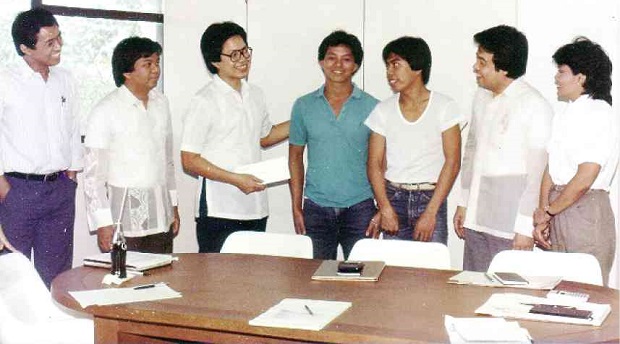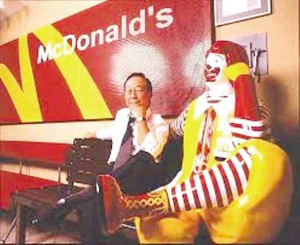Multiplying buns and patties

FROM left: marketing manager Roberto Suarez, vice president for finance Ferdinand Manto, operations manager Edgar O. Cruz, (employees of the month), president and CEO Manuel Azcona, and vice president for administration Sonia Azcon
Tony Tan, it’s true, is not the pioneer of fastfood in the Philippines. But he accomplished more than that: he built Jollibee to become the pioneer Filipino global fastfood brand. Yes, global.
Before fastfood chains became wildly popular, Tropical Hut supermarkets had a coffee shop famous for its aromatic coffee and hamburger served on a plate. That was in the 70s. At that time, Jollibee was an ice cream house with pancit palabok in the menu. In 1978, Tan and his siblings converted their ice cream houses into a burger chain. George Yang’s first McDonald’s store with its all-American menu and English-speaking crew on Morayta St. at the University Belt was years away from inauguration, in 1981.
If none of the existing fastfood brands claims the distinction of being the country’s pioneer fast-food chain, that’s because Big Twenty owns that distinction, having introduced limited menu, standardized preparation procedure, self-service, and disposable packaging to the restaurant industry.
A homegrown company that opened its flagship outlet on Escolta St. in 1977, Manuel Ascona—from the family that originally owned and operated Tropical Hut—conceptualized Big Twenty as a newly returned immigrant from Australia.
The business plan was to open 20 outlets in Metro Manila, thus the brand name. Diversifying our eating habits, forever changing it, Big Twenty turned into a case of the Biblical multiplication of the fishes and bread loaves. Only this time the miracle is with buns and patties, that is, beef patties, not pork, as indicated by the misnomer “hamburger.”
At Big Twenty, the burger-fries-soda combo on a plastic tray with a newsprint placemat was a fast and filling alternative served within a minute—and may be taken out, if one were in a rush.
Escolta was still Metro Manila’s bustling financial district back then with Ayala Avenue as its booming counterpart. Although expanding, our eating-out choices then did not include Italian, Japanese and Thai fares, although their availability was limited to the five-star hotels and specialty restaurants that already dotted the shopping centers in that pre-mall era.
Big Twenty’s first outlet was across the Philippine National Bank high-rise headquarters in Escolta. It was a strictly western approach of vending food, no imaginative presentation or packaging, only the promise of a filling delicious meal at a reasonable cost repeated each time. It became a crossover hit that led to two more outlets in Manila, plus one each in Makati, Cubao and Greenhills in a matter of two years.
Even if it had a winning business formula, being homegrown had its quirks. It had to start its operational system from scratch: the burger patty was a mix, not in frozen form; french fries had to be manually peeled from local potatoes in a commissary, not imported Grade A frozen shoestring; easiest to implement was the softdrink as dispensers were readily available from the two main brands of softdrinks then.
Here lies the company’s collapse: lack of financial clout, marketing inexperience, and zero operational backup that made the company lost out to competition.
Before the entry of multinationals, local hamburger brands were attacked by the cultivated worm food scare. An uninformed market was particularly susceptible, so sales nosedived. Without expert advice on how to deal with the earthworm scare, it was the start of the major blows to hit the growth business sector.
Even before the crisis was over, Big Twenty was forced to spend on equipment to live to the challenge of other brands. It splurged on an expensive television campaign, but the looming reality proved to be a do-or-die affair as competitors could do everything better.
On the other hand, Jollibee successfully countered McDonalds’ entry with a frontal attack with its superior business sense. It upgraded its menu with the Langhap Sarap handle. But even as the gambit hit McDonald’s hard, it was not strong enough to affect McDonald’s expansion plans. The burger giant countered with a flank attack by introducing the innovative bone-in Chicken McDo and the unheard-of McSpaghetti to cater to a uniquely local partiality.
A fire hit Big Twenty’s offices at Ayala Avenue headquarter, and then an economic crash followed Benigno Aquino’s assassination. Only the strong survive and Big Twenty had more weaknesses than strengths. Even with a great product, it was a first-line candidate for meltdown, the collateral damage of the early ’80s political and economic turmoil.
Big Twenty’s business concept also proved shortsighted as Metro Manila market is enormous, good for 200-plus units for the brand leaders. This allowed Jollibee to beat business pioneer/leader McDonald’s at its own game. Jollibee expanded in major Filipino population hubs around the globe.
Through franchising and by diversifying its menu to suit local tastes and demands such as the addition of halo-halo, Jollibee built itself to become the Philippines’ first global fast food system, proving Malthus’ theory wrong with the miracle of buns and patties through vertical expansion.
Tan and Azcona synergized. With Yang providing the world-class model, both must be jointly given the credit of introducing fast food in the country, with the Jollibee mastermind deserving the bigger credit for morphing itself into the country’s leading fast-food chain with multi-brand licenses and global linkups.


